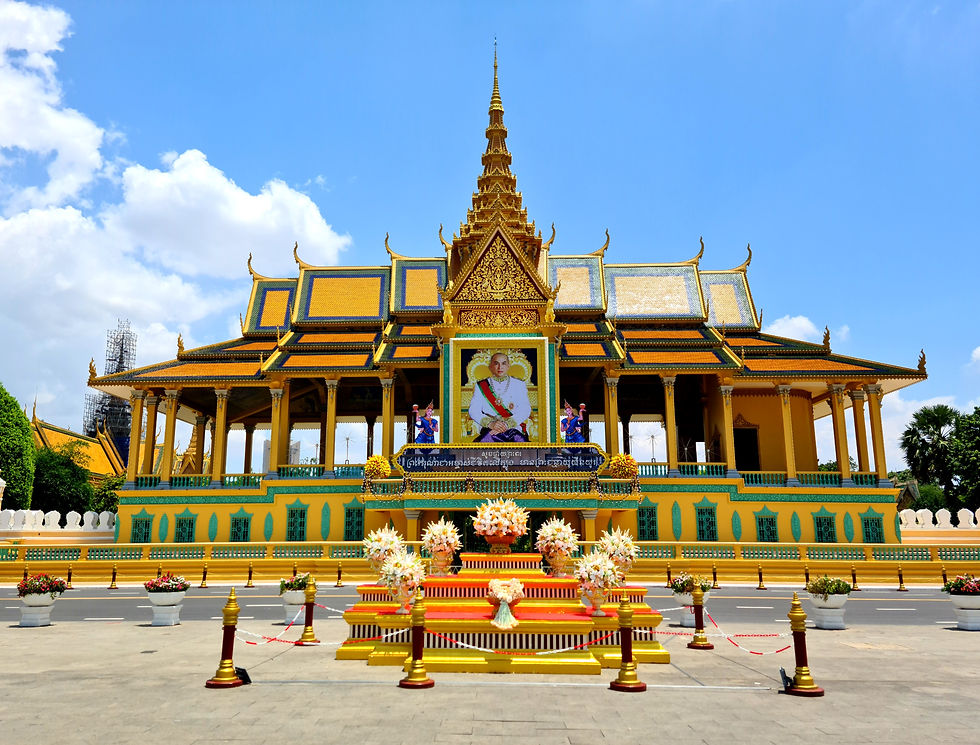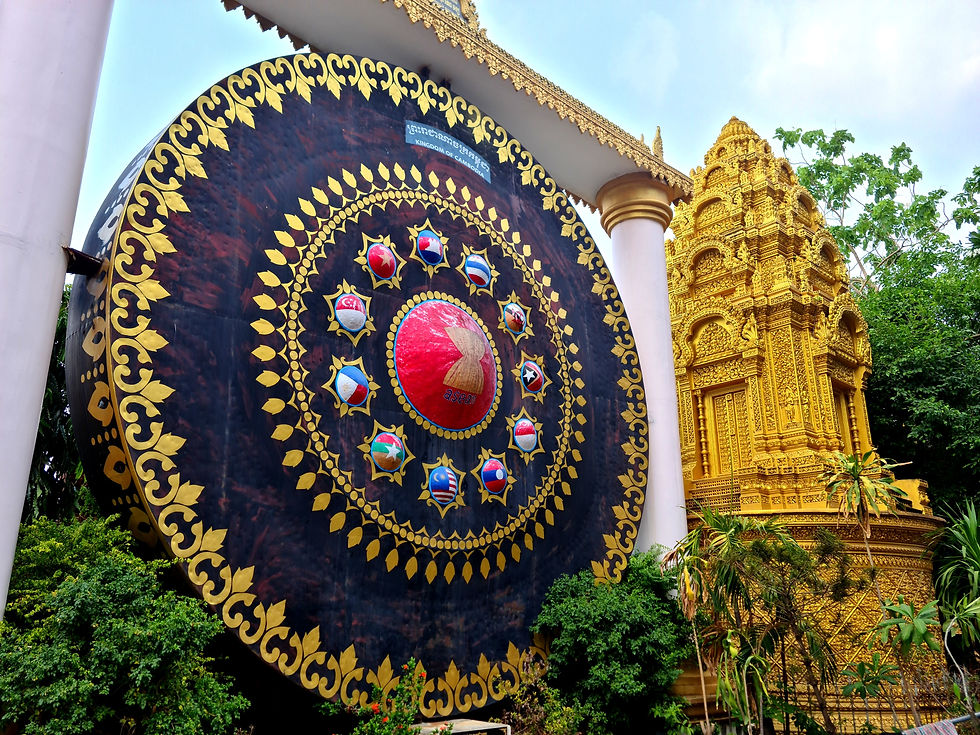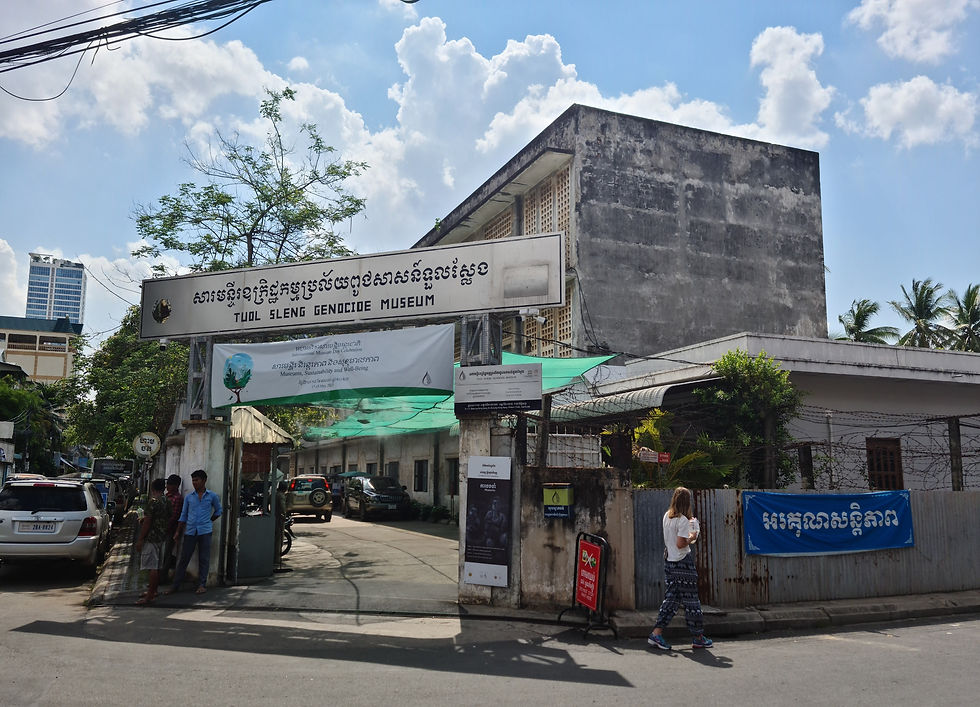
Our time in Vietnam absolutely flew by, and before we even knew it, we were heaving our backpacks onto the bus headed for the Cambodian border. Six hours later, we had already arrived in Phnom Penh, the capital city of Cambodia.
The border crossing went off without a hitch. We handed our passports to the tour guide at both the Vietnamese and Cambodian borders, and he handed them on to the immigration officers in batches. While everything was being sorted, we went for lunch and then simply collected our passports and walked across the border to get back on the bus on the other side. We had had a few concerns about needing to "grease some palms" to get across the border based on anecdotes and stories we had heard from other travellers but using the bus company as an intermediary everything went very smoothly.
Phnom Penh offers both fantastic river views of the Mekong and Tonle Sap and important historical sites to explore. If you want to learn more about Cambodia's more recent history, including the dreadful genocide committed under Pol Pot and the Khmer Rouge Regime, I highly recommend visiting some of the city's most prominent museums.

We spent our first day in Phnom Penh wandering its streets and discovering some of the city's most striking sites. As we walked the expansive, well-maintained promenade along the Tonle Sap River, the golden rooftops and stupa's of Wat Ounalom Monestary soon emerged before us. The Monestary dates back all the way to 1443 and is the seat of Cambodia's Maha Nikaya Order, one of the two principal monastic orders of modern Thai and Cambodian Buddhism. The Maha Nikaya Order is the largest order of Theravada Buddhism in Thailand and Cambodia, taking up over 90% of Thai Buddhist monks. This makes Wat Ounalom the most important religious site in Phnom Penh and the heart of Buddhism in Cambodia. The name Ounalom refers to the sacred artefact housed in the Wat's stupa, which is said to contain one of the eyebrow hairs of Buddha himself.

From the Monestary, it is only a short walk to the Royal Palace. Like many sites in Phnom Penh, the palace closes from 11am to 2pm, as this is when the sun beats down on the open courtyards and streets the strongest. For a fee of 10 USD per person, you can visit one half of the palace complex. This includes the throne hall, in which coronation ceremonies take place, the Silver Pagoda and the Chan Chhaya Pavilion. The other half of the complex is in active use as the King's residence and closed to the public.

From the palace, we headed south towards Tuol Sleng Genocide Museum, also known as S-21. The museum was set up on the site of a former secondary school used as a security prison during the rule of the Khmer Rouge from 1975 to 1979. During that time, the Khmer Rouge decimated the population of Cambodia and committed atrocious acts of torture and genocide against its own people. It is estimated that of the ca. 7.9 million people living in Cambodia before 1975 almost 2 Million had lost their lives by 1979 accounting for nearly 1/4 of the entire population. The Khmer Rouge believed that Cambodian society needed to be de-evolved and turned back into a self-sufficient, agrarian community with communist values. To achieve this, they abolished money, private property, formal education, religion, and traditional cultural practices. All major cities were emptied of their population, their inhabitants being relocated to forced labour camps in the countryside to tend a growing number of rice fields designed to sustain the population. This new rural population, consisting primarily of urbanites, received little to no training on how to farm land or tend to rice fields, leading to crop yield failures, severe malnutrition and disease running rampant in the communities. This, in addition to the severe physical abuse and harsh manual labour, caused a first wave of mass deaths. As the second measure in building an agrarian society, the Khmer Rouge systematically eradicated anybody they considered as "new people". This included monks, ethnic minorities, artists, foreigners and intellectuals such as doctors, engineers and teachers. Anyone who held a divergent belief system or higher level of education was hunted in an attempt to "purify the population". It is estimated that 60% of the loss in population under the Khmer Rouge is attributed to direct executions. One of the 196 prisons used across Cambodia to hold and torture these so-called enemies of the state, was Security Prison 21 (S-21), today the site of Tuel Sleng Genocide Museum. Of the estimated 20,000 prisoners that passed through S-21 from 1975 to 1979, there are only 12 known survivors. Prisoners at S-21 were tortured and coerced into giving falls confessions and implementing friends and family members in their alleged crimes. During the first year of the regime, prisoners were executed and buried on site. By 1976, however, so many people had been killed at S-21 that they had run out of space for graves. At this time, the regime opened Choeung Ek, better known as the killing fields. Prisoners would be tortured into giving a confession at S-21 and were then transported to Choeung Ek for their brutal execution and burial in one of the many mass graves set up here. Our visit to S-21 was chilling. Seeing former classrooms and jungle gyms turned into prison cells and torture devices was an incisive experience. The museum is set up well and has an excellent audio guide which includes explanations and interviews with some of the survivors. I would highly recommend visiting both Tuel Sleng and Choeung Ek to get a better understanding of the events that have so profoundly influenced and changed Cambodia.
Comments